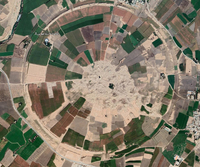Ardashir-Xwarrah (Firuzabad)
Date:
224
Location or Findspot (Modern-Day Country):
Iran
Medium:
Stone,
Terra-cotta
Description:
Before he became the first Sasanian shahanshah, Ardashir I (r. 224–42) defeated the last Parthian ruler and founded a new capital city on the site of one destroyed by Alexander "the Great" (d. 323 BCE). The new city was known as Ardashir-Xwarrah ("Royal Glory of Ardashir"), or by its earlier name, Gur. It was circular in plan, with a diameter of almost 2 kilometers. The city had four gates and was surrounded by a clay wall and a ditch; inside, were three concentric and twenty radiating streets. Most buildings were made of mud-brick except for those in the fortified center. These included a 30-meter-tall central tower called the Terbal and a domed fire temple, the latter built of stone ashlars and incorporating pre-Parthian (Achaemenid) spolia. The adjacent palace of Ardashir bears traces of Persepolis-style stucco work. The circular city plan was an unprecedented ideological statement that announced the central position of the shahanshah and his capital city in the new Sasanian empire.
Ardashir's son Shapur I built a new capital, but his fathers' city was not forgotten. Several other Sasanian cities were built on a circular plan, and when the Abbasids built their capital at Baghdad in 762, it too was circular (1 km diam.), with four gates. The Buyid dynasty (934–1062), which claimed descent from the Sasanians, may have renovated Ardashir's old palace. They changed the city's name to Firuzabad, "City of Victory," ostensibly because gur meant grave in tenth-century Persian.
Ardashir's son Shapur I built a new capital, but his fathers' city was not forgotten. Several other Sasanian cities were built on a circular plan, and when the Abbasids built their capital at Baghdad in 762, it too was circular (1 km diam.), with four gates. The Buyid dynasty (934–1062), which claimed descent from the Sasanians, may have renovated Ardashir's old palace. They changed the city's name to Firuzabad, "City of Victory," ostensibly because gur meant grave in tenth-century Persian.
Relevant Textbook Chapter(s):
1
Repository and Online Resources:
• Firuzabad and its environs are a UNESCO World Heritage site.
Image Credits:
Google Earth, Wikimedia Commons, Carole Raddato






